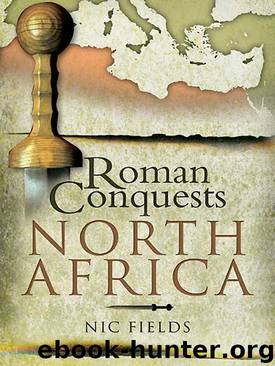Roman Conquests: North Africa by Nic Fields

Author:Nic Fields
Language: eng
Format: epub
Tags: Roman Conquests: North Africa
ISBN: 9781844159703
Publisher: Pen and Sword
Published: 2011-01-25T16:00:00+00:00
Throwing off all semblance of negotiations, in the spring Scipio sent a small body of troops towards Utica equipped with a siege train. The ploy was to make the Carthaginians believe that he was about to reopen the siege. It worked, for the collective attentions of Hasdrubal and Syphax were fully occupied when Scipio made his night attack on their respective camps. Syphax’s men were asleep in their huts of reeds and foliage, the famous mapalia, and these Masinissa and Laelius torched.13 Syphax’s men, believing that the fire was an accident, were either incinerated in their huts, trampled to death in the rush to escape the flames, or cut down as they tried to escape the camp. Meanwhile, Hasdrubal’s men in the other camp, also thinking the fire was accidental, rushed out, some to assist their allies, some to simply goggle in growing alarm. Scipio then fell upon those who had come out, killing some and driving the other back into the camp, to which he immediately set fire, with horrifying results as their huts, made of wood and branches, went up in flames too. In this way the combined forces of Hasdrubal and Syphax perished, though the two leaders themselves managed to get away.14
Amazingly, Hasdrubal and Syphax then set about and succeeded in raising another ragtag army, in which the only reliable fighters were the Celtiberians, who had been recruited in central Iberia from one of the toughest of the peninsula’s many warlike tribes. With this army, in the spring of 203 BC, they confronted Scipio at the Great Plains.15
In the spring Scipio had marched with something like 20,000 men in light marching order to the Great Plains where, if Polybios is to be believed, an army of 30,000 Carthaginians, Numidians and Celtiberian troops had gathered.22 For two days the two sides skirmished, no doubt taking the measure of each other, discovering as much as they could about their respective strengths and weaknesses. On the third day, Hasdrubal Gisgo and Syphax deployed their combined forces, placing the Numidian horse on the left wing, the Carthaginian cavalry on the right, and the 4,000 Celtiberians in the centre along with the Numidian foot levies. Following the usual Roman practice, Scipio deployed his legions and alae in triplex acies, with the Roman and Latin-Italian cavalry, under Laelius, facing Syphax’s Numidians on his right wing, and Masinissa’s Numidians facing the Carthaginian cavalry on the left.
At the first charge the battle passed irredeemably out of Carthaginian hands, as both cavalry wings gave way, soon to be followed by the Numidian foot, so exposing the flanks of the Celtiberians in the centre. Though Polybios says no more than that these fierce warriors were then ‘swiftly surrounded by the principes and triarii’, it would seem that Scipio replayed the tactics he had successfully employed at Ilipa.23 If this was indeed the case, he would have held the Celtiberians frontally, though this time probably engaging them directly with the hastati, and then extended his fighting line, by
Download
This site does not store any files on its server. We only index and link to content provided by other sites. Please contact the content providers to delete copyright contents if any and email us, we'll remove relevant links or contents immediately.
The Daily Stoic by Holiday Ryan & Hanselman Stephen(3264)
The Fate of Rome: Climate, Disease, and the End of an Empire (The Princeton History of the Ancient World) by Kyle Harper(3030)
People of the Earth: An Introduction to World Prehistory by Dr. Brian Fagan & Nadia Durrani(2711)
Ancient Worlds by Michael Scott(2648)
Babylon's Ark by Lawrence Anthony(2648)
The Daily Stoic by Ryan Holiday & Stephen Hanselman(2523)
Foreign Devils on the Silk Road: The Search for the Lost Treasures of Central Asia by Peter Hopkirk(2442)
India's Ancient Past by R.S. Sharma(2432)
MOSES THE EGYPTIAN by Jan Assmann(2393)
The Complete Dead Sea Scrolls in English (7th Edition) (Penguin Classics) by Geza Vermes(2258)
Lost Technologies of Ancient Egypt by Christopher Dunn(2208)
The Earth Chronicles Handbook by Zecharia Sitchin(2203)
24 Hours in Ancient Rome by Philip Matyszak(2065)
Alexander the Great by Philip Freeman(2044)
Aztec by Gary Jennings(1992)
The Nine Waves of Creation by Carl Johan Calleman(1898)
Curse Tablets and Binding Spells from the Ancient World by Gager John G.;(1851)
Before Atlantis by Frank Joseph(1832)
Earthmare: The Lost Book of Wars by Cergat(1806)
